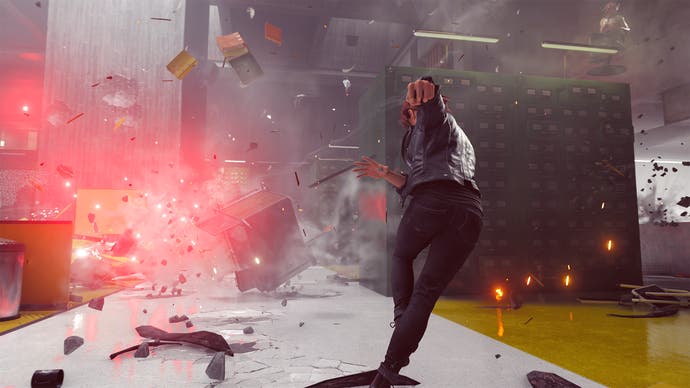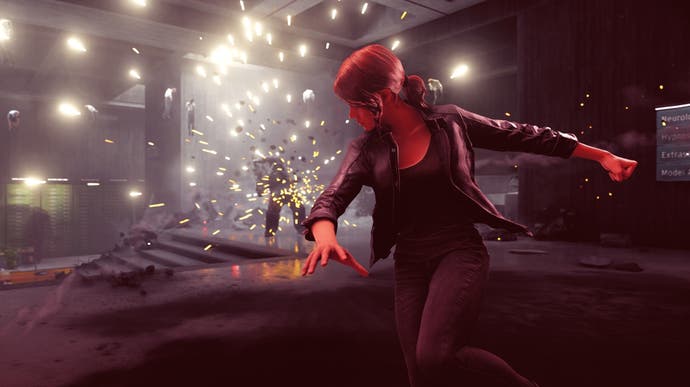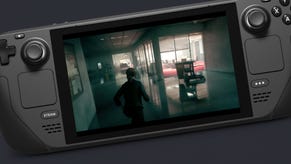Back in Control: Remedy's weird new world feels brilliant to play
And the "exhale" after Microsoft's Quantum Break.
Even if you did happen to be in Finland, Remedy Games is still off the beaten track. You need to drive out of Helsinki along snow-ploughed roads, across a bridge, over a frozen lake where people play ice hockey and on to the next town, a place named Espoo, to eventually find the studio's new office. The building, a brutalist pile of concrete and glass, was built for a private medical firm. Now, a recently-added machine in the entrance takes a mugshot of your face and immediately emails it to the staff member you're meeting. "You have to do this," I'm told, "since some fans managed to get in".
I'm sort of impressed they made the journey, but once you're within Remedy's walls you're reminded why they made their trip. The studio has cultivated an offbeat personality over the years - the same personality it poured into cult hits like Alan Wake and Max Payne. There's a sauna in the basement, I'm told, as we pass a row of seaside deck chairs on a landing facing south, ready for the few minutes of bright sunlight Finland gets once in a while. And now more than ever, I think, Remedy embodies a sense of proud independence - worn outwardly through the ubiquitous staff hoodies which act like an optional uniform, and inwardly by the bodies which toiled for five long years building too-ambitious TV-series-slash-video-game hybrid Quantum Break for Microsoft. More on that, though, in a bit.
It's not too much of a narrative leap to see this slightly weird building in the virtual one I'm here to explore - its cavernous concrete spaces and branching corridors, cramped staircases and side-rooms. You probably know Control's backstory already: lead character Jesse Faden has inherited the directorship of a secret US government agency designed to investigate supernatural phenomena, and which has unwisely set up shop within the eye of the paranormal storm. It's here, within the Bureau of Control's headquarters, Jesse will prove she's the right person for the job, rid the building of possessed former agents, and uncover answers to why things have gotten so weird. But weird, I'm happy to say, is a lot of fun.
Unlike Remedy's offices, Control's world is filled with waves of possessed gun-toting agents, each throng a bespoke mix of sharpshooters, tanks, and mysterious orb creatures which buff enemies around them. Remedy has cooked up a complicated under-the-hood encounter system so when you're exploring the game's Metroidvania-like map - and backtracking through it - you're not overwhelmed at every turn. If you've just caused a ruckus in the room next door you may find yourself getting a breather - at least for a little while.
"Let's try to make a statement. That's part of the exhale after Quantum Break."
Control director Mikael "Mixu" Kasurinen
But combat is perhaps Control's strongest suit. Fights are wild, breathless, and encourage plenty of experimentation. I felt like Jesse was learning alongside me as I worked out how best to mix gunplay and power combos, all while floating in mid-air. The Service Pistol, one of the best-looking weapons in pretty much any game, is the only gun in Control. But it comes with multiple forms you can switch between (two can be active in your loadout at any one time) and then tweak using different tiers of weapon mods you'll find dropped by enemies or in far-off rooms hidden in chests. My favourite was the Pierce form, a rangey rifle option that lets you shoot through cover and even, if you line up your shot, through multiple enemies. You can find character mods, too, so you can choose to tailor Jesse's loadout to fortify her health, ability duration and so forth depending on a specific encounter.
Control's world isn't just filled with enemies, however - there are staff still alive in the bureau to meet, chat with and receive missions from. Some of these relate to Control's overall story - how the current crisis began, how it can be resolved - while others are side-missions designed to give Remedy's world a little more colour. Back at E3 last year, for example, we saw poor Phillip, a forgotten staff member left looking after an "altered", deviant fridge. In Control, seemingly mundane items must continually be observed or they will, Weeping Angel-like, devour those who look away. Agreeing to help Phillip eventually leads to you "cleansing" the fridge and being dragged into the game's bizarre Astral Plane, described by Remedy as a sub-dimension which can also handily gift Jesse new abilities. These new powers then unlock fresh areas to explore.


In another mission, we meet high-ranking bureau employee Helen Marshall, holed up in a section of the Bureau focused on experimental research. Luckily for Marshall, her job was manufacturing gadgets which keep people safe from possession. Unluckily, a spiky ball of energy from the Astral Plane has escaped into her department. So begins a puzzley section where you have to kite the energy tornado - which looks a bit Lost smoke monster - around an area to eventually trap it within an airlock. It's a cool set-piece, and the environmental damage from the enemy as it whips about, splintering furniture and research equipment, offers some real eye candy. This demo is the first to show how Control runs on console (PlayStation 4 Pro) and six months out from release it's already looking polished.
The mission then dives into the Astral Plane, a vivid white space filled with looming shapes and moving platforms, and it's here, after a big boss fight, we learn the Seize ability, which compels weakened enemies to fight on your side. This new tool is perfect for those enemies that buff others, which are now compelled to buff you. Last year's demo showed how Jesse can launch herself into the air, levitate and shield herself from bullets. This new build includes evade and ground-pound manoeuvres. My favourite is the Mass Effect-like vanguard charge, which can zoom you across rooms. It's meant for combat, but acts as a fun method of traversal, too.
A sandboxy area I played, the Central Research lobby, offers perhaps the most indicative experience of what Control will be like to play. Free from mission constraints, I'm allowed to simply explore a chunk of the map and poke around its corners - take a hidden lift down into an overgrown staff toilets block, now home to slimy mould and dripping ferns, where I find a new legendary character mod. Back up to the lobby and I try another door, which leads me into a plush study area whose walls move around as I do, the dimensions of the room cascading outwards in front of my eyes. These areas exist to be explored but aren't key to the game's overall plot - unlike the linear narrative in Remedy games of the past, the studio wants you to linger in its creation.

"We want to keep building worlds, but make them places you explore," Control's director Mikael "Mixu" Kasurinen tells me a little later, "not just blast through in one story arc then you're done. The world should be something that exists which you can find more things to do with." It feels a common problem for games which previously would have lasted 10 hours and then gone back on the shelf - something made all the more obvious after the mammoth development of Quantum Break. "We were looking at people playing Quantum on Twitch," Remedy communications manager Thomas Puha remembers. "We'd spent four to five years on it and then it was over for them in eight hours. There's something very strange about that. We want to make sure we can keep building on Control for a while to come."
"We played it safe with Quantum Break in many ways. We wanted to get weird again."
Mikael "Mixu" Kasurinen
The launch of Control is just the beginning for its world, Remedy is keen to stress. When you're done with the main game and side-missions, you'll be given post-game "Bureau Alerts", a feature which still remains under wraps. With Control, Remedy is spending time to create something it hopes you'll want to return to after the end of its core story, that you may still be puzzling over.
"Let's be honest, we're not one of the massive studios around the world, but we're still independent," Kasurinen continues. "This is our own IP, we decide what's going to happen with it. The smartest thing for us is to do what we believe in, be ready to be a bit weird, be controversial even - let's try to make a statement than play it safe. That's part of the exhale after Quantum Break. Control is very much an expression of that."
Remedy hasn't said much about how Quantum Break played out versus its expectations. At launch, the PC and Xbox exclusive received a mixed reception, with praise for Remedy's style and visuals but more of a shrug for its live action episodes, which felt a hangover from Microsoft's failed push into TV. But it speaks volumes Remedy has for its next project created a new IP it holds the rights for, chosen to release it via a smaller publisher - 505 Games - and showed it first to the world last year via Sony's PlayStation E3 conference. "It's a statement, I guess," Kasurinen says, when I remark that the first console hands-on with Control is also on PlayStation 4 Pro units. "The more people who play our games, the better," he adds, diplomatically. "It's something we've wanted to do for a while now."


Where Quantum Break told a Hollywood-style time travel story, Control is offbeat and indie feeling in a way Remedy hasn't been since Alan Wake. "With Quantum Break we talked about wanting to - for the lack of a better word - be mainstream," Kasurinen says. His team was building a big budget exclusive for Microsoft, after all. "We carefully chose things and maybe sometimes avoided certain things we love. We were anxious about being too weird. We played it safe with Quantum Break in many ways. After coming out from it we felt we wanted to do something different. We wanted to get weird again.
"You can look back at Quantum and say, maybe it's the farthest we've gone regarding storytelling. There's a live action TV show, extremely long, complicated cinematics, really elaborate facial animation systems. It's as far as we could go with storytelling from a visual perspective. This [Control] is us taking gameplay and a complicated universe and an open ended experience and going as far as we can from a Remedy perspective regarding those."
On the far wall of the office, there's a roadmap of work still to do before the game's launch in August - and beyond. Papers cover over the latter months of the year. If this was a room in the Bureau of Control, it would be good environmental storytelling. "There will be two expansions," Puha details, when I ask what's next. Named Foundation and AWE, these will only go into full production when the main game wraps. "But we also want to release content in between," Puha continues, "as the first expansion is not going to come two months after we ship - we want to take our time with it."
These smaller content drops might answer what's behind a locked door, or take players to a new floor - the studio isn't yet willing to say. Whatever happens, they're designed to keep players unravelling the mysteries of Control a while longer. And I understand that impulse, I think. After all, it's something I wanted to do, long after leaving Remedy's studio, and winding my way back home.
This article is based on a trip to Remedy Games. 505 Games provided transport and accommodation.










